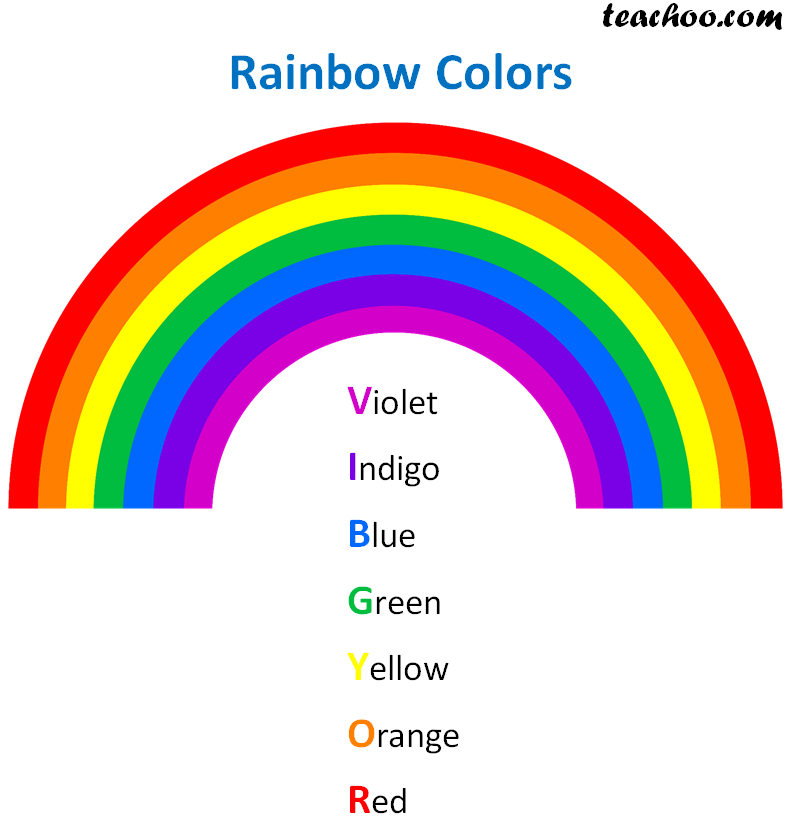Have you ever stopped to truly admire a rainbow? It’s not just a beautiful arc in the sky; it’s a captivating display of nature’s artistry, a symbol of hope, and a source of scientific wonder. But how many colors are truly there? You might say seven, right? Red, orange, yellow, green, blue, indigo, and violet, the colors we learned in school. But the answer, as with most things natural, is a little more nuanced and intriguing.

Image: www.teachoo.com
The colors we perceive in a rainbow, and how we categorize them, are closely tied to the way our eyes and brains interpret light. Understanding this process is key to truly appreciating the complexity of this colorful phenomenon, and it’s not just about the colors themselves; it’s about the science, the history, and the cultural connections that make rainbows so captivating.
The Science of Color and Light
Let’s dive into the science first, as it’s the foundation for understanding what we actually see in a rainbow. Sunlight, seemingly white, is in fact made up of a spectrum of colors, each with its own wavelength. When sunlight passes through raindrops, the light gets bent, or refracted, due to the difference in the speed of light in air and water. This bending causes the different colors to separate and become visible as a rainbow. It’s like a prism separating white light into its component colors, but on a massive scale.
Beyond ROYGBIV: The Deeper Rainbow Spectrum
While ROYGBIV is the familiar acronym for the colors of the rainbow, it’s an oversimplification. The truth is, the rainbow spectrum is a continuous gradient of colors. Think of it like a painting, where one color slowly blends into the next. There are countless hues and shades, and where one color “ends” and another “begins” is subjective. For example, where does orange end and yellow begin? It’s a seamless transition.
The Historical Perspective: Ancient Beliefs and Modern Interpretations
Rainbows have fascinated people for millennia. In ancient cultures, rainbows were often interpreted as divine signs. For instance, in Greek mythology, Iris, the goddess of the rainbow, served as a messenger between gods and mortals. Rainbows have also been associated with good luck, prosperity, and the promise of peace.
Modern science has provided a more rational understanding of the rainbow phenomenon, while the symbolism and cultural significance endure. Rainbows continue to inspire poets, artists, and scientists alike, serving as a reminder of the beauty and complexity of the natural world.

Image: www.pinterest.co.uk
Rainbow Diversity: Global Perspectives and Cultural Significance
As we’ve learned, the “colors” of a rainbow aren’t just about the science; they are also imbued with cultural meaning. Different societies around the world have their unique interpretations of rainbows, often associating them with specific deities, legends, and traditions.
For example, in some cultures, rainbows are seen as a connection between the earth and the heavens, symbolizing peace and harmony. In others, they are viewed as a bridge between the living and the dead. These diverse interpretations highlight the rich tapestry of human understanding and the power of nature’s wonders to inspire awe and reflection.
Beyond the Visual: The Emotional Impact of Rainbows
Rainbows evoke a profound emotional response in many people. The vibrant hues, the fleeting nature, and the unexpected appearance all contribute to a sense of wonder and joy. The rainbow is often associated with hope and optimism – a symbol of beauty arising from storms and challenging times.
The Practical Side of Rainbows: Using a Rainbow Through a Lens
Rainbows aren’t just a spectacle to behold; they can be studied and analyzed using scientific tools. Scientists use spectrometers to break down light into its component colors, analyzing the wavelengths to learn about the composition of stars, planets, and other celestial objects.
Rainbows also play a crucial role in photography and visual art. Photographers use lenses and filters to capture the vibrant colors and dramatic effects of rainbows, while artists find inspiration in their beauty and mystique.
Beyond the Rainbow: The Spectrum of Color in Our Lives
The rainbow, in its simple elegance, reminds us of the limitless spectrum of color that surrounds us. From the vibrant hues of flowers and birds to the subtle shades of the sky at sunset, color plays a vital role in how we experience the world.
Color influences our emotions, affects our perception of space, and even affects our health and well-being. It’s a profound reminder that the seemingly mundane can be transformed into something extraordinary through the lens of curiosity and appreciation.
How Many Color Are In The Rainbow
Exploring the Rainbow: A Call to Action
Now that you have a deeper understanding of the rainbow’s beauty, complexity, and significance, go forth and explore its many facets. Look for rainbows in nature, read about historical interpretations, appreciate the artistic expression inspired by them, and share your observations with others. Each rainbow, a unique and fleeting masterpiece, holds within it a universe of stories waiting to be discovered.






